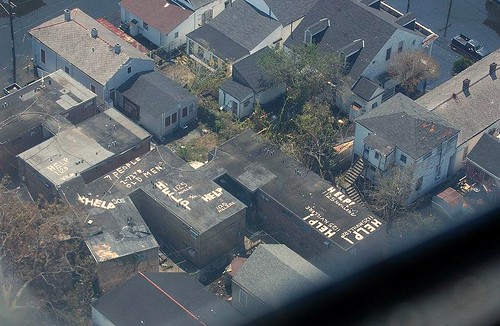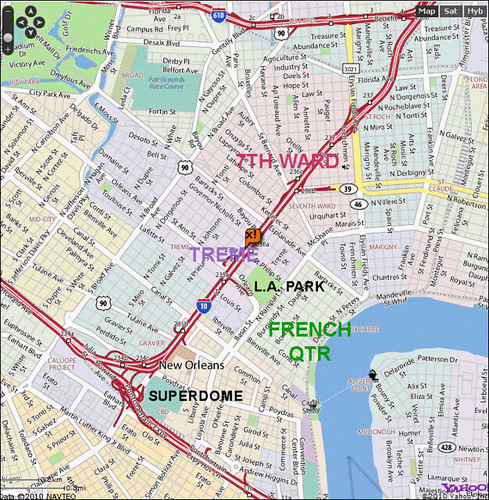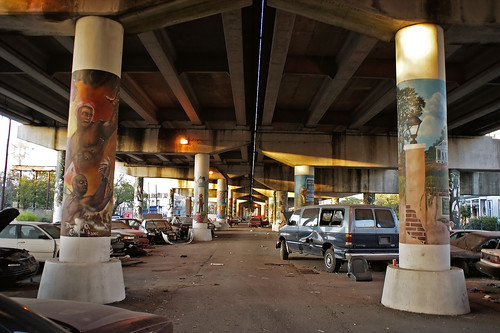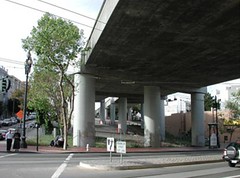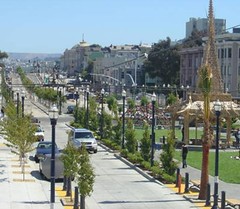To aid NOLA recovery, tear down the expressway & restore the neighborhoods

Posted August 30, 2010 at 1:33PM
As we reflect on the five years that have passed since Hurricane Katrina devastated New Orleans, we can observe both progress and much, much left to be done. At Xavier University yesterday, President Obama spoke for many when he said that despite progress there are still too many vacant lots, too many people unemployed and "too many New Orleanians who have not been able to come home." Writing for the Associated Press, Cain Burdeau and Michael Kunzelman also report that the President noted the harsh reality that the recession and the Gulf oil spill have only compounded the challenges of recovery.
Rebuilding one of our nation’s most loved (if also impoverished) cities has been inherently a matter of planning and architecture, and the task has brought out many ideas, some fabulous, others well-intentioned but falling short of the mark, in my humble opinion.
Enter two of my close professional friends with another idea that I think is absolutely inspired: tear down the aging eyesore of an elevated expressway that for 40 years has ripped the historic Tremé neighborhood (photo above during Katrina) in half, contributing mightily to its decline. Replace it with a complete-street boulevard that can become an asset and catalyst for the community’s recovery – functioning, in fact, much like the avenue now deteriorating underneath the highway had functioned before its majestic trees were removed and its businesses demolished to make way for more concrete.
The highway is a two-mile stretch of Interstate 10; the boulevard-in-waiting-below, North Claiborne Avenue. The two friends are David Dixon of Goody Clancy architects, lead author of the recently undertaken and massive master plan for the city of New Orleans, and John Norquist, president of the Congress for the New Urbanism and former mayor of Milwaukee. As far as I know, the two haven't collaborated but simply came to the same conclusion in separate inquiries. And, like many good city ideas, it is not just theirs alone, of course: Tremé residents and other enlightened New Orleans citizens have been considering it for years.
Writing last year on nola.com, the web site for the New Orleans Times-Picayune, Lolis E. Elie reported that “removal of the Claiborne Expressway was proposed by the two-year-old Unified New Orleans Plan and is a key recommendation in the city's draft master plan." The article quotes David as saying that "I-10 is something that lots and lots of people complained about, especially in terms of its damage to Tremé."
Elie goes on to write how the highway was originally proposed to go through the French Quarter (!), where neighborhood activists were able to defeat it. But, as in so many NIMBY battles, one group’s victory became another’s loss, in this case that of the less affluent and less influential African-American neighborhood to the Quarter’s immediate northwest:
“North Claiborne, like its southern end uptown, was a wide boulevard with a large neutral ground running down its middle. Unlike South Claiborne Avenue, North Claiborne was also home to a magnificent collection of live oak trees.
“It was the central artery for Mardi Gras Indian parades and other celebrations that, by the 1950s, were displaced by several federal policies that encouraged the development of suburban communities and highways.”
Elie's excellent writing includes a longtime neighborhood resident’s description of Claiborne Avenue in the 1950s:
“[Armand] Charbonnet calls out the names of the old businesses and their specialties: The Capital Theater. LaBranche's Drug Store. People's Life Insurance. Two Sisters Restaurant. Albright's Sewing Machine Shop, Gilbert's Toy Store, Elite's Drug Store.
"’Joe Sheep's sandwich shop used to open up at 6 in the evening and close about 2 in the morning,’ Charbonnet said. ‘He had five-cent stuffed crabs, five-cent stuffed tomatoes. The highest sandwich he had was 15 cents for hot sausage. At Moe's pie shop, you had hot pies every evening at 4.’
“Charbonnet speaks of the businesses with a familiarity born of an era when most of the travel along North Claiborne Avenue was on foot -- at a pace that allowed passers-by to read and digest the signs along the way . . .
"’That was like black people's Canal Street,’ said Charbonnet, 78, who was born in the building that houses Charbonnet-Labat Funeral Home, his family business at St. Philip Street and North Claiborne Avenue in Tremé.”
Turning to John’s (Norquist’s) contribution, he and Clifton James (an architect who studied restoring Claiborne back as far back as 1976) penned an op-ed in the Times-Picayune that appeared last week. The two observe that the citizens of New Orleans now considering the freeway tear-down are in the same position that residents of Milwaukee, San Francisco (before and after photos above) and New York have also been in recent decades: all successfully replaced freeways with surface streets (in Milwaukee’s case, under John’s leadership as mayor), to the benefit of neighborhoods. The two write:
“The ground-level boulevard, with three lanes in each direction, would have as much capacity as the expressway. Intersections at each block would let drivers take back routes to relieve congestion.
“Will businesses really return? Will the area feel safe? Currently, thousands of potential customers per day stream overhead. The underbelly makes pedestrians want to be elsewhere. By bringing traffic to street level and creating a park-like environment for pedestrians, the boulevard would become a more vibrant place with more businesses putting "eyes on the street" to enhance safety. That's exactly what has happened in other cities.
“Despite protests from predominately African-American neighborhood residents and business owners, construction of Interstate 10 erased the oak-lined avenue that had been a strolling route for Louis Armstrong and other famed New Orleanians. The 132 businesses the street supported in 1960 shrank to 35 by 2000. Restoring the boulevard offers an opportunity to fix an oppressive mistake and create rich soil for growing diverse, locally owned businesses, as well as creating jobs for people native to this community. It is the best way to make the corridor a prized asset that brings hope to Tremé and lower Mid-City and works for all of New Orleans.”
Last month CNU, along with the local Claiborne Corridor Improvement Coalition, issued a 60-page report providing a detailed plan for making the change and accommodating traffic. According to a Times-Picayune article written by Bruce Eggler, the document says eliminating the expressway would, in addition to removing an eyesore, reduce noise and air pollution, increase opportunities for public transit, and promote investment that would eliminate blight and create economic development in the Treme and 7th Ward neighborhoods.
This storied community deserves no less. Check out this short video tour of the Tremé hosted by Wendell Pierce, who plays trombonist Antoine Batiste in the great HBO series anchored in the neighborhood. Louis Armstrong Park, where the video begins, is just two blocks southeast of the freeway and Claiborne (see map):
Move your cursor over the images for credit information.
